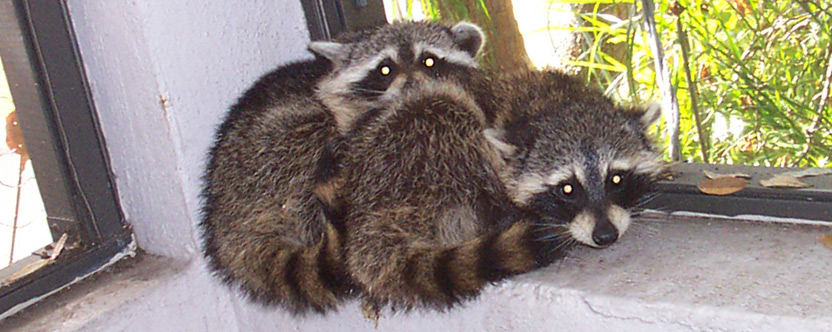NEED LOCAL HELP? We have wildlife removal professionals servicing 95% of the USA. Click here to hire a local raccoon removal expert in your home town. Updated 2018. But read the below advice first!
Raccoons usually mate during springtime, in the months of February and March. Although this is the normal mating season, raccoons may start copulating as early as December and still come together for breeding as far into the year as June. Solar conditions fail to provide an explanation as to the differences in mating time frames from region to region.

Female raccoons have a short window to achieve conception, only three to four days per mating season. Adult females or female yearlings that don’t get pregnant during breeding season or lose their litter shortly after giving birth will sometimes become fertile again in the following two to four months. Male raccoons usually became sexually mature only after their first mating season, but it’s not the same for female yearlings that more often than not reach sexual maturity just in time for mating season. It’s not uncommon for first-time mother raccoons to be responsible for about half of the cubs born that year, especially in areas where raccoon mortality is high.
During mating season, male raccoons will wander tirelessly searching for females. During the three to four days in which conception is on the table, raccoons will meet as a social group, foreplay and copulation being repeated during these nights, with sessions that last for about an hour. And while the strongest male will always get the chance to ensure the survival of its genes by copulating with more females, it is not uncommon for some females to mate with more than one male. And because the strongest male in the social group can’t possibly mate with all the available females, the weaker males also eventually get the chance to breed. The urban female raccoon will give birth to an average of two to three litters during her lifetime. The kits will usually be born in the months of April and May, in batches of three to five.
Somewhere between two to four months after they’re born, baby raccoons are weaned and start exploring the great outdoors by following their mother. During the first year of their lives, she will show them lots of feeding places, and teach them complicated acrobatics.
With the arrival of fall, the kits will become independent, although it’s not uncommon for them to spend their first winter denning with their mother, especially in northern regions where the weather is colder. Once they become independent, female raccoons may not roam so far away from home. Males, on the other hand, will often move into territories that are more than 12 miles away. This is instinctive behavior on their part, a way of avoiding inbreeding.
If you have a raccoon in your attic, it is more than likely that you’re dealing with a female raccoon that has a litter. Always check for babies when you have a raccoon intruder in your attic. And check thoroughly, because mother raccoons are very protective, and know where to hide the babies. For the untrained eye, it may be very difficult to find the litter.
Go back to the Raccoons in the attic home page.